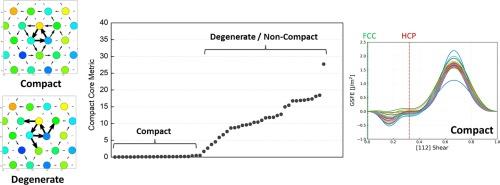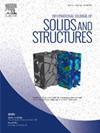控制 BCC 原子间位势中的螺钉位错核心结构和 Peierls 势垒
IF 3.4
3区 工程技术
Q1 MECHANICS
International Journal of Solids and Structures
Pub Date : 2024-07-29
DOI:10.1016/j.ijsolstr.2024.113004
引用次数: 0
摘要
对于 BCC 金属中的螺钉位错,有三个谜团一直存在,即紧凑型与退化型内核结构、单驼峰与双驼峰 Peierls 势垒,以及内核结构与 Peierls 势垒之间的关系。我们发现紧凑型内核由 FCC 堆积序列中的原子组成,而退化型内核由 HCP 堆积序列中的原子组成,这表明必须考虑 BCC、FCC 和 HCP 才能正确捕捉内核结构。在机器学习模型的指导下,我们可以生成能可靠预测紧凑型内核结构的原子间势。我们还进一步证明了紧凑型核心结构并不一定会导致单驼峰 Peierls 势垒。本文章由计算机程序翻译,如有差异,请以英文原文为准。

Controlling screw dislocation core structure and Peierls barrier in BCC interatomic potentials
For screw dislocations in BCC metals, three mysteries have persisted, that is, compact vs degenerate core structure, single-hump vs double-hump Peierls barrier, and the relation between the core structure and Peierls barrier. We discover that the compact core consists of atoms in a FCC stacking sequence and that the degenerate core consists of atoms in a HCP stacking sequence, suggesting that BCC, FCC, and HCP must be considered to correctly capture the core structure. Informed by a machine learning model, we can generate interatomic potentials that reliably predict a compact core structure. We further show the compact core structure does not necessarily lead to the single-hump Peierls barrier.
求助全文
通过发布文献求助,成功后即可免费获取论文全文。
去求助
来源期刊
CiteScore
6.70
自引率
8.30%
发文量
405
审稿时长
70 days
期刊介绍:
The International Journal of Solids and Structures has as its objective the publication and dissemination of original research in Mechanics of Solids and Structures as a field of Applied Science and Engineering. It fosters thus the exchange of ideas among workers in different parts of the world and also among workers who emphasize different aspects of the foundations and applications of the field.
Standing as it does at the cross-roads of Materials Science, Life Sciences, Mathematics, Physics and Engineering Design, the Mechanics of Solids and Structures is experiencing considerable growth as a result of recent technological advances. The Journal, by providing an international medium of communication, is encouraging this growth and is encompassing all aspects of the field from the more classical problems of structural analysis to mechanics of solids continually interacting with other media and including fracture, flow, wave propagation, heat transfer, thermal effects in solids, optimum design methods, model analysis, structural topology and numerical techniques. Interest extends to both inorganic and organic solids and structures.

 求助内容:
求助内容: 应助结果提醒方式:
应助结果提醒方式:


